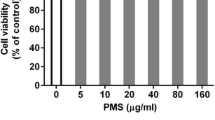Abstract
The present study aimed to evaluate the effect of naringenin on protection in lipopolysaccharide (LPS)-induced injury in normal human bronchial epithelium (NHBE) and to provide insights into the possible underlying mechanisms. NHBE were stimulated by LPS in the presence or absence of the narigenin. In vitro treatment with naringenin led to a significant attenuation in the LPS-induced NHBE secretion of tumor necrosis factor alpha (TNF-α), interleukin-6 (IL-6), superoxidase dismutase (SOD), nitricoxide synthase (NOS), myeloperoxidase (MPO), and nitric oxide (NO). RT-qPCR demonstrated that naringenin significantly reduced the LPS-induced upregulation of TNF-α, IL-6, and nuclear factor kappa-light-chain-enhancer of activated B cells (NF-κB) p65 mRNA expression in a dose-dependent manner. Additionally, Western blot analysis revealed that naringenin effectively suppressed NF-κB activation by inhibiting the degradation of IκB-α and the translocation of p65. Naringenin also attenuated mitogen-activated protein kinase (MAPK) activation by inhibiting the phosphorylation of ERK1/2, c-Jun NH(2)-terminal kinase (JNK), and p38 MAPK. Taken together, these demonstrate that naringenin reduces TNF-α and IL-6 secretion and mRNA expression, possibly by blocking the activation of the NF-κB and MAPK signaling pathways in LPS-treated NHBE. These results indicated that naringenin had a protective effect on LPS-induced injury in NHBE.








Similar content being viewed by others
References
Venkayya, R., M. Lam, M. Willkom, G. Grünig, D.B. Corry, and D.J. Erle. 2002. The Th2 lymphocyte products IL-4 and IL-13 rapidly induce airway hyperresponsiveness through direct effects on resident airway cells. American Journal of Respiratory Cell and Molecular Biology 26: 202–208.
Hamilton, L.M., D.E. Davies, S.J. Wilson, I. Kimber, R.J. Dearman, and S.T. Holgate. 2001. The bronchial epithelium in asthma-much more than a passive barrier. Monaldi Archives for Chest Disease 56: 48–54.
Holgate, S.T. 2000. Epithelial damage and response. Clinical and Experimental Allergy 30: 37–41.
Velden, V.H., and H.F. Versnel. 1998. Bronchial epithelium: morphology, function and pathophysiology in asthma. European Cytokine Network 9: 585–597.
Moon, D.O., C.M. Lee, J.H. Kang, B.H. Kim, Y.H. Oh, and Y.M. Park. 2004. Epigallocatechin-3-gallate, constituent of green tea, suppresses the LPS-induced phenotypic and functional maturation of murine dendritic cells through inhibition of mitogen-activated protein kinases and NF-kappaB. Biochemical and Biophysical Research Communications 313: 148–155.
John, E., P. Pais, N. Furtado, A. Chin, J. Radhakrishnan, L. Fornell, A. Lumpaopong, and U.H. Beier. 2008. Early effects of lipopolysaccharide on cytokine release, hemodynamic and renal function in newborn piglets. Neonatology 93: 106–112.
Rogers, J., I. Perkins, O.A. Van, N. Burdash, T.W. Klein, and H. Friedman. 2005. Epigallocatechin gallate modulates cytokine production by bone marrow-derived dendritic cells stimulated with lipopolysaccharide or muramyldipeptide, or infected with Legionella pneumophila. Experimental Biology and Medicine 230: 645–651.
Hallstrand, T.S., T.L. Hackett, W.A. Altemeier, G. Matute-Bello, P.M. Hansbro, and D.A. Knight. 2014. Airway epithelial regulation of pulmonary immune homeostasis and inflammation. Clinical Immunology 151: 1–15.
Bhargava, R., W. Janssen, C. Altmann, A. Andres-Hernando, K. Okamura, R.W. Vandivier, N. Ahuja, and S. Faubel. 2013. Intratracheal IL-6 protects against lung inflammation in direct, but not indirect, causes of acute lung injury in mice. PLos ONE 8: e61405.
Lauder, S.N., E. Jones, K. Smart, A. Bloom, A.S. Williams, J.P. Hindley, B. Ondondo, P.R. Taylor, M. Clement, C. Fielding, A.J. Godkin, S.A. Jones, and A.M. Gallimore. 2013. Interleukin-6 limits influenza-induced inflammation and protects against fatal lung pathology. European Journal of Immunology 43: 2613–2625.
Berry, M., C. Brightling, I. Pavord, and A. Wardlaw. 2007. TNF-alpha in asthma. Current Opinion in Pharmacology 7: 279–282.
Brightling, C., M. Berry, and Y. Amrani. 2008. Targeting TNF-alpha: a novel therapeutic approach for asthma. Journal of Allergy and Clinical Immunology 121: 5–10.
Koch, L., B. Fritzsching, D. Frommhold, and J. Poeschl. 2011. Lipopolysaccharide-induced expression of Th1/Th2 cytokines in whole neonatal cord and adult blood: role of nuclear factor-kappa B and p38 MAPK. Neonatology 99: 140–145.
Abraham, E. 2000. NF-kappa B activation. Critical Care Medicine 28: 100–104.
Nanashima, N., M. Akita, T. Yamada, T. Shimizu, H. Nakano, Y. Fan, and S. Tsuchida. 2008. The hairless phenotype of the Hirosaki hairless rat is due to the deletion of an 80-kb genomic DNA containing five basic keratin genes. Journal of Biological Chemistry 283: 16868–16875.
Jain, A., A. Yadav, A.I. Bozhkov, V.I. Padalko, and S.J. Flora. 2011. Therapeutic efficacy of silymarin and naringenin in reducing arsenic-induced hepatic damage in young rats. Ecotoxicology and Environmental Safety 74: 607–614.
Hirai, S., Y.I. Kim, T. Goto, M.S. Kang, M. Yoshimura, A. Obata, R. Yu, and T. Kawada. 2007. Inhibitory effect of naringenin chalcone on inflammatory changes in the interaction between adipocytes and macrophages. Life Sciences 81: 1272–1279.
Dou, W., J. Zhang, A. Sun, E. Zhang, L. Ding, S. Mukherjee, X. Wei, G. Chou, Z.T. Wang, and S. Mani. 2013. Protective effect of naringenin against experimental colitis via suppression of Toll-like receptor 4/NF-κB signalling. British Journal of Nutrition 110: 599–608.
Lyu, S.Y., and W.B. Park. 2005. Production of cytokine and NO by RAW 264.7 macrophages and PBMC in vitro incubation with flavonoids. Archives of Pharmacal Research 28: 573–581.
Acknowledgments
We are grateful to M.D. Xin Jin for assistance with statistical analysis.
Author information
Authors and Affiliations
Corresponding author
Rights and permissions
About this article
Cite this article
Yu, Dh., Ma, Ch., Yue, Zq. et al. Protective Effect of Naringenin Against Lipopolysaccharide-Induced Injury in Normal Human Bronchial Epithelium via Suppression of MAPK Signaling. Inflammation 38, 195–204 (2015). https://doi.org/10.1007/s10753-014-0022-z
Published:
Issue Date:
DOI: https://doi.org/10.1007/s10753-014-0022-z




